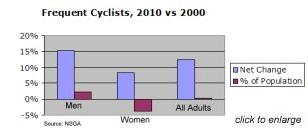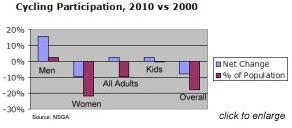I finally got my hands on the National Sporting Goods Administration's (NSGA) 2010 report on the US Bicycle Market.
In addition to being some of the most exciting news we've seen in 20 years (more about that in a minute), it's also by far the easiest to interpret … mostly because instead of digesting the whole report, I got a pre-release copy of the?Gluskin Townley Group's?analysis, as written by Brad Edmundson. Even better, you can get your own copy for free: just scroll down to the bottom of the post for ordering information.
So what makes the 2010 report so exciting? Simple: it looks like maybe, just maybe, all the hard work we've been doing as an industry to grow the market for enthusiast cyclists might actually be paying off.
Or maybe not.
To quote from the report:
Over the last decade, bicycling has become less popular, but more visible. The bicycle market in the US is not growing, yet it has the potential to become far more profitable. What made this happen? Simple. While bicycling faded as a pastime, it grew as a sport.
Or to put it another way, evidence shows that the US bike business has succeeded in cultivating— and actually?growing?— a European-style class of enthusiast cyclists. That's pretty darned good news.
The bad news, of course, is that, unlike our colleagues on the other side of the Atlantic, we've accomplished this growth by largely ignoring all the other people, the ones who might want to ride bicycles on a more causal basis. But more about that in another post.
Here's the bottom line — and as a note, while the numbers are verbatim from the folks at GTG, the interpretations are my own.
The Good News
Cycling participation among adults is up slightly, by a modest but encouraging 2 percent. In fact, the overall number of cyclists has posted small gains on a yearly basis since 2000. So does this mean that ten years of advocacy is starting to turn things around for the industry? Maybe — see the following section. Cycling participation among adult men is up?a very healthy 16 percent overall.

Frequent adult riders?— those who ride at least 110 days per year —?increased by 12 percent. Men were up 15 percent, and while women's participation decreased overall, the number of women who ride frequently is up by 8 percent over the past decade. To me, that's one indication that our efforts to market women's cycling may be starting to succeed.
The Not-So-Good News
Kids' participation continues to decline alarmingly.?While the number of adult cyclists is increasing slightly,?Only 20 percent of children ages 7-17 are riding bikes even six times per year, versus 25 percent in 2000. Women's participation continues to decline. While the number of frequent women riders has increased (see above), the overall number is down a net 10 percent ... which means the number of casual (infrequent) women riders is down by even more, by 14 percent.? As the reports says,?The number of women who ride frequently increased by more than 100,000 between 2000 and 2010, even as the total number of women riders decreased by almost 1.3 million.

Overall participation continues to decline. While the number of adults riding bikes is up slightly, the exodus of kids and casual women riders means the overall number of folks riding bikes is down 8 percent overall in the past decade, and it's driven by women and, to a lesser extent, kids leaving the sport. On a per capita basis, it's worse than that. When you correct for the fact that the US population overall has grown 10 percent in the past decade, the overall decline is more like 18 percent.
My Note: This is a lot more than just fear-mongering; statistically, the distinction is important. If we're trying to measure the gross output of the industry, we should look at the base numbers. If we're trying to measure our ability to penetrate the market, we should look at per capita. Both are important metrics, but they measure very different things.
So What's It Mean?
Like a lot of reports, you can make the 2010 NSGA numbers mean pretty much anything you want them to. Advocacy types will point to the steady growth of the number of cyclists over time, and with some justification. Enthusiasts and bike brands will look at the growth of their core "Frequents" group — and especially the growing adoption of frequent cycling by women — as a selling point.
Here's what the report has to say:
?As the cycling universe shrank around the edges, its core got harder.? Over the last decade, the industry has benefitted from rapid growth in groups that promote "bicycle culture," which integrates bicycling into daily patterns of work and play. Groups like the Rails to Trails Conservancy have become effective advocates for cycle touring, while the International Mountain Bicycling Association and other groups are giving people better ways to plug into performance-oriented cycling. Meanwhile, urban activists have formed organizations in virtually every metropolitan area in the US, such as Transportation Alternatives in New York City, to promote bicycling as a form of daily transportation and exercise.?
These groups have re-defined American bicyclists as a special interest group.? They are the main reason why the numbers of American adults who ride a bicycle at least 110 days a year increased 12 percent during the decade, even as the total number of adult riders was essentially flat (see table 2).? And in a particularly important finding, women appear to be sharing in the growth of bicycling culture.? The number of women who ride frequently increased by more than 100,000 between 2000 and 2010, even as the total number of women riders decreased by almost 1.3 million.
?I really like that phrase,?These groups have re-defined American bicyclists as a special interest group.?For me, that's the biggest single takeaway of the entire report. And depending on how you read it, it's either a good thing or a serious threat to our future as an industry.
But these are just the highlights. (Well, that plus some snarky comments from me.) The report itself is eight well-written pages, packed with a lot more information than I've been able to touch on here, including a number hard-hitting conclusions which I'll leave for another post. It's very well presented, too, and best of all, the folks at GTG are giving the whole thing away, for free.
To get your copy?just drop Jay Townley a line at?Jay (at-sign) gluskintownleygroup (dot) com?...and tell him I sent ya.
Disclaimer: Rick Vosper was an Associate of the Gluskin-Townley group from 2008-2010. He is not currently affiliated with them, nor does he especially like referring to himself in the third person.





